Flame sensors are critical components in heating systems that detect the presence of a flame to ensure safe and efficient operation. Proper flame sensor reading is essential for maintaining optimal performance and longevity of the heating system. This comprehensive guide will provide you with the technical details and step-by-step instructions to accurately measure and interpret flame sensor readings.
Understanding Flame Sensor Readings
The flame sensor signal typically comes from an intermittent spark module or the main control board. When the flame is lit, the flame sensor should read between 0.5 and 10 microamps (μA), with readings between 2 and 6 μA being the most common. This microamp reading indicates that the flame sensor is functioning correctly and detecting the presence of the flame.
Factors Affecting Flame Sensor Readings
Several factors can influence the flame sensor reading, including:
-
Furnace Grounding: Proper grounding of the furnace is crucial for accurate flame sensor readings. Ensure that the furnace is properly grounded to prevent interference and ensure accurate measurements.
-
Polarity: The polarity of the flame sensor connections must be correct. Reverse polarity can lead to inaccurate readings or even prevent the flame sensor from functioning properly.
-
Flame Rod Position: The flame rod must be positioned correctly within the flame to ensure accurate readings. The rod should be positioned such that it is fully immersed in the flame.
-
Meter Settings: When checking the flame sensor, it is essential to set the multimeter to the microamp (μA) scale with a resolution of at least 0.10 μA. This ensures that the readings are precise and accurate.
-
Wiring Configuration: The leads should be connected in series, with one lead connected to the flame rod and the other to the terminal on the control board, with the connector unhooked from the rod.
Troubleshooting Flame Sensor Issues

If the flame sensor reading is outside the expected range of 0.5 to 10 μA, it is necessary to investigate the issue further.
No Flame Sensor Signal
If there is no signal from the flame sensor, it is important to determine whether the issue lies with the control board or the module. In some cases, the wiring may be thick and shielded to protect against electromagnetic interference due to the low current.
Cleaning the Flame Sensor
Flame sensors may have a surface treatment intended to deter the buildup of deposits that could reduce conductivity. Abrasive cleaning might improve performance in the short term, but the benefit might deteriorate over time. It is crucial to clean the sensor carefully to avoid damaging the coating or leaving behind grit that can lead to a coating and poor conductance once heated.
Maintaining Optimal Flame Sensor Performance
Regular maintenance and cleaning of the flame sensor can help ensure optimal performance and longevity of the heating system. It is recommended to follow the manufacturer’s guidelines for cleaning and maintenance to maintain the integrity of the sensor’s surface treatment.
Conclusion
Proper flame sensor reading is crucial for the safe and efficient operation of heating systems. By understanding the technical details and following the step-by-step instructions provided in this guide, you can ensure that your flame sensor is functioning correctly and maintaining optimal performance. Remember to always prioritize safety and consult with a professional if you are unsure about any aspect of the flame sensor reading or maintenance.
References
- Flame Sensor: What Should the Volts Read?
- Measuring Flame Signal & Cleaning Flame Sensors
- Checking Micro Amps on Flame Sensor
- Flame Sensing: The Basics
- Flame Sensor Troubleshooting

The lambdageeks.com Core SME Team is a group of experienced subject matter experts from diverse scientific and technical fields including Physics, Chemistry, Technology,Electronics & Electrical Engineering, Automotive, Mechanical Engineering. Our team collaborates to create high-quality, well-researched articles on a wide range of science and technology topics for the lambdageeks.com website.
All Our Senior SME are having more than 7 Years of experience in the respective fields . They are either Working Industry Professionals or assocaited With different Universities. Refer Our Authors Page to get to know About our Core SMEs.